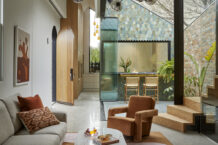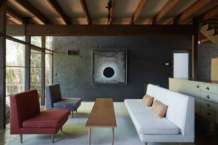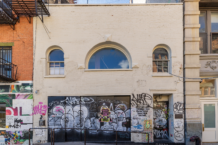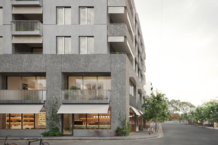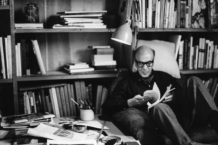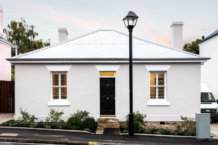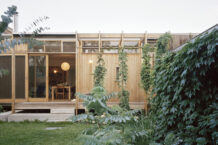Saigon: The Blank, Abroad.
Open Musings - by Open Journal
-
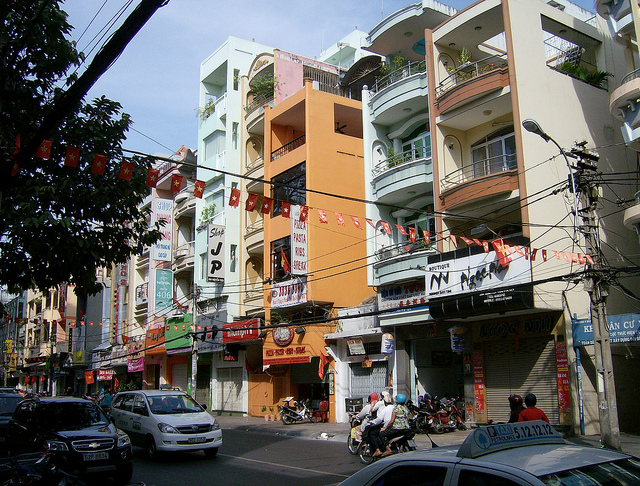
Ho Chi Minh City Saigon Vietnam. Photo: Joseph Hunkins
20,000 leagues above the great red heart of Australia, I drew out my notebook and started taking down the first notes of what would become this, a brief summary of the results of a fortnight spent in the fabled Ho Chi Minh City, formerly Saigon, in southern Vietnam. I was travelling on a trip of architectural discovery, culinary experimentation and social enlightenment, travelling to a land of hyper-dense neighbourhoods spanning the voids between cluttered main roads and steadily proliferating podium tower developments, a land of countless mopeds forming the mass shoals of transportation that so closely mirror the social networks of the city’s population.
The title of this article is ‘Saigon: The Blank, Abroad’ because I went into this trip in a state of deliberate ignorance; my mind a tabula rasa on which I was hoping to craft an appreciation of a society through my own eyes. I was not without experience in this endeavor, as an international upbringing had deposited me at varying times in Singapore, Jakarta, Kuala Lumpur and further north in the great cities of China, and I had long since decided that Saigon was likely to be yet another part of this region that I would happily get to know.
Landing in Ho Chi Minh City you are typically going to be a bit uneasy because everyone you know who has been there before is likely to have warned you against being pick-pocketed. I was perfectly willing therefore to patiently sit – read: shelter inside the airport terminal, slowly thinking up my next step for a good half hour before emerging unto the crowded drop-off area, navigated my way through hordes of taxi drivers offering me exploitative rides before finally reaching the ‘sanctioned’ taxi brands – VinaSun or MaiLyn – the ones which have meters in them, and being whisked away to my very distant hotel.
I noted immediately the finer grain of the city, the narrow store fronts which made up the prevailing typology of most of the 10 or so Districts which make up the main environs of the city: the tube houses. Conceived apparently as a reaction to French colonial tax rates which were based on the width of a frontage, the tube houses riddle the urban fabric of the city – lining main roads or comprising the chief fabric of the ‘hem’ neighbourhoods which I had come to the city to study. Varying in dimensions according to District, a typical dwelling in the district I was going to focus on – District 3 – was four to five meters across the front, fifteen to twenty meters deep and an impressive two to four – or even five – storeys high.
The tube house becomes, in much the same way as the moped, the dictating scale of the wider city. I was told that 60% of Vietnamese are self-employed, and this astounding figure becomes believable when you note that the ground floor of almost every tube house along the main roads is converted into a private business of some description – anything from a small pharmacy, to a small grocer, to a drinks bar among many other variations. The economy is built on a million tiny enterprises; the dictating values of the city exerted from the bottom, upwards. Venture a few steps into the two meter broad backstreet corridors of the hem neighbourhoods and the ground floor businesses persist – interspersed liberally with stunningly public displays of family privacy: siestas a few meters from the sidewalk, conversations in loved living rooms briefly halting as the stranger walks by.
My hotel was situated clear across the CBD suburbs of the city, on the far side to the northern airport in the more southerly District 7. A hotel which was conceived with good intentions – as an outlying branch of a well-known central facility, positioned to take advantage of business flowing through the nearby docks – a good fifteen years ago. My abode and the breakfast buffet there offered had seen better days but this was exactly what I was after: an authentic, removed, little considered experience. The room may have lacked the adequate lighting and sterile cleanliness that it’s faux wood furnishings and cavernous shower may have suggested to have been the original intention, but it was generously sized – the bed seemed to exceed King designation – and permanently (I saw to this personally) air conditioned.
If the tube house is a symbol of the way of life long prevalent in Ho Chi Minh City, then the hotel that I was staying in was a precursor to the globalized future that a steadily growing economy may yet render unto the city at large. A large footprint building, perhaps notionally higher density thanks to the dozens of hotel rooms stacked within, but crucially more desirable in the eyes of a wider world: more impressive, less ostensibly slum-like than the exceptionally dense neighbourhoods of yesteryear. Some might say the proliferation of these new tower like buildings, with their colossal footprints which wipe out entire hem neighbourhoods at a stroke, is something of a cancer on the social fabric of the city: drawing people out of the closely knit and coherent communities clustered together in the first three or five storeys above street level and thrusting walls and slabs between them, taking them up and away from the streetscapes that are the lifeblood of the city and stripping a huge swathe of residents of their now traditional private business frontages.
I do have an anecdote which I believe describes the nature of the social fabric which is apparently in some danger. It concerns the events of my third or fourth day in town, when I set off from a base on the border of Districts 1 and 3, not far from the Notre Dame Cathedral, towards a section of intriguingly organized Hem in the western end of District 3. I would later be told that this hem neighbourhood is known as the ‘chequerboard hem’, and that it is so ordered because it was rebuilt in the 1970s after the original hem in the area had burned down during the war. Passing the touching monuments to Thích Quảng Đức, the monk who self-immolated in 1963 in protest against the poor treatment of Buddhists by the government of Ngo Dinh Diem, one passes from the more developed eastern half of the District – riddled with government buildings, schools and French Colonial holdovers – and into the more earthy western reaches.
While I use the term ‘earthy’, what I really hope to describe is a more socially robust urban condition. Not far down the main shopping road, I turned right on a whim and – somewhat holding my breath – I prepared to strike deep into the heart of the acutely dense communal atmosphere of the hem. I have touched on hem already in this interview, but a brief description of the experience of traversing these micro-neighbourhoods is best placed here: Those few steps down the hem that I mentioned earlier are not merely steps away from a street, they are steps into an utterly different atmosphere. The sounds of the street are muffled, the hot light of the sun is obscured by the high walls of the narrow laneways, the temperature drops and only the occasional grate of a passing moped breaks the gentle hubbub of a thrumming community purring along just a few meters from your tentative steps. As a westerner the feeling is distinctly uncomfortable: one feels very much the trespasser, and attempts to avert the eyes from one deeply personal scene or another are not always successful. The line between the public and the private is blurred in the hem, and passing through it is a difficult experience, but after a hundred meters or so headed north among the dwellings I broke out into an east-west running semi-commercial street, lined with typical small enterprises and therefore rather less uncomfortable for apprehensive old me.
I wandered briefly along this lane before a cheerful cry of “Hello how are you!” was hollered at me from the depths of a drinks bar. I delivered a polite “Hullo!” back before moving past said shop, doubling back on second thought after noticing that a fantastic view of the deep and various condition of the hem – for an artist I fancy myself, handy with a pen and relishing any chance to sketch – was on offer should I sit at a rickety steel table they had set outside a window. Sitting down and ordering a cheeky Pepsi, I was pleased to find that the young son of the family which owned the shop and above tube house could speak quite a passable – if halting – brand of English. I would go on to spend three hours at the drinks bar, sketching the streetscape before me while conversing with the cheerful young fellow occasionally sitting down beside me in the moments between his chores. I sampled local food from carts, greeted and conversed in impossibly restricted terms with other residents, and learned of the situation in which I found myself.
My friend would confide in me at last that life in the hem was at once difficult and warm: everyone is a family member somehow, he reflected, but one is simultaneously never really able to pin down a moment of private time. I would quiz him later about the composition of the tube house above our heads, and he allowed that he shared a bedroom with his brother. He also occasionally warned me that “bad, bad people” exist in the hem, that I should keep an eye on my personal belongings in case interlopers happen upon them and decide to lighten my load.
I would go on to visit this delightful family, whose handsome sons and beautiful mother somewhat adopted me over the two weeks, a number of times, but this particular anecdote peaks with the events which followed that first night of sketching, when my lightweight 18 year old buddy offered to ride me to my distant hotel on the back of his moped in a typical gesture of extremely generous host instincts which would be repeatedly offered to me going forward. This would not be the first time I experienced this mode of transportation – an epic experience in Jakarta on New Year’s Eve 2015 as well as a ride earlier in this very trip were already under my belt – but things were interesting this time around as the beanpole driver was always going to struggle somewhat with my 85kg, 183cm frame, and because I had jokingly volunteered to direct him to my hotel with hand gestures, an offer he immediately and unexpectedly accepted.
This was no small challenge – four days into my residence in Ho Chi Minh City I was expected to direct my youthful driver through four separate Districts, through a myriad of turns, over bridges, through chaotic intersections and roundabouts ringed with zooming tail lights that looked in vista as though they belonged in that psychedelic sequence in 2001, all the while making allowances for one-way streets which I had not taken note of during my prior perambulations. The journey itself proved to be hilariously elongated by the drastic detours that I directed my friend down in retracing the tracks of my daily taxi drivers. I would later learn that a more direct route existed, but that my friend preferred to take me on the longer route because it offered him more chances to practice his English.
It was during this journey that something struck me about the society which I was inhabiting and the structures which kept it purring. The moped commute, I deduced, was a perfect metaphor for the hem neighbourhood. Both conditions are collaborative, socially dynamic situations involving the give and take, surge and yield, the concession and the claim. To partake in a shoal – few words would better describe this – of mopeds in Saigon is to engage in a thoroughly social, close quarters, if essentially wordless experience. In much the same way, living in a hem is to engage in a close quarters, daily social mixing pot and communal collaboration. The metaphor can be extended, perhaps unfortunately, to incorporate the consequences of globalization: just as the hem is steadily being replaced by the massive, socially segregated and fracturing presence of the podium luxury apartment block, so the motorcycles are being inexorably traded in for cars – hermetically sealed capsules, designed to encapsulate and isolate users from the pesky obligations of a wider, more social world.
In my position as a willing ignorant, Saigon struck me as a city of dense social and built fabrics, entering the early approaches to a globalized social condition that so many other major cities in South East Asia seem to have gone through over the past decade or two. The fabric of the city may resist this change for a long time – the hem are highly successful micro-neighbourhoods which not only accommodate a certain economic level of society, but allow for it and sustain it – but the march towards proliferation of these new buildings seems as though it will never be truly reversed, even halted, even delayed or in any way resisted. This city will never be the same again – indeed it changes with each passing moment – and for better or worse this renders it one of the most socially charged and dynamic urban realities I have ever witnessed. Do consider witnessing it yourself, but I urge you to carry the tabula rasa with you: go in fresh, choose a distant hotel, filter through the Districts like coffee into a cup, and appreciate the segmented and dusty hem for what they are.
Words: Richard McPhillips








